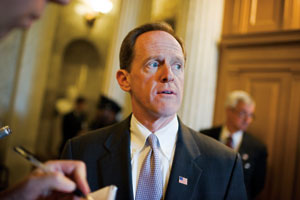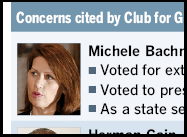CQ WEEKLY – IN FOCUS
July 2, 2011 – 11:20 a.m.
A Very Businesslike Rivalry for Clout
By Joseph J. Schatz, CQ Staff
The granite edifice of the U.S. Chamber of Commerce sits across Lafayette Park from the White House. From that proximity to power, the almost century-old Chamber claims to represent the interests of about 3 million business enterprises, from the very largest corporations to the smallest one-person shops.

|
||
|
In the political maelstrom swirling around raising the limit on federal government borrowing by the Aug. 2 deadline set by the Treasury Department to avoid a first-ever default, the Chamber is allied in principle with President Obama. It wants Congress to raise the debt ceiling quickly and to avoid the demands of tea party-backed conservatives for historic spending cuts as the price. “We’ve consistently conveyed our belief that the debt limit should not become a political football,” says Blair W. Latoff, the Chamber’s communications director.
Six blocks away are the offices of the upstart Club for Growth, a decade-old conservative organization that has made its name by targeting moderate Republicans at the polls — with some success — in an aggressive effort to push the GOP farther to the right on economic issues.
The Club stands strongly opposed to almost any increase in federal borrowing, and sees the debt-limit fight as a golden opportunity to assert its agenda. It is trying to hold the feet of Republican lawmakers to the fire, threatening them with primary challenges if they yield on this critical matter.
So which group represents good old-fashioned American business? Therein lies one of Washington’s other, quieter battles. The Chamber says it speaks for American companies. The Club says it speaks for the free-enterprise system at its core. And while the Chamber is much more well-heeled, spending tens of millions of dollars in the last election and planning the same for the 2012 campaigns, the Club is fast positioning itself as an intellectual and political rival.
Their discord over the debt limit has yet to escalate into a public shouting match, but it underscores the economic tensions within the Republican Party in the run-up to 2012. The fact that the Club is helping drive the debt limit debate illuminates the challenge facing GOP leaders — particularly House Speaker
The Club tracks voting records closely and is making clear to Boehner and other top Republicans that they are being watched. David Keating, the group’s executive director, recognizes the conflict and makes no apologies for his organization’s assertive posture.
“They’re a business organization,” Keating says of the Chamber. “They do what is good for big business, but not necessarily good for free enterprise.”
Drawing Distinctions

|
||
|
On most major economic issues — taxes, regulation and international trade — there is little disagreement between the Club and traditional business groups. Indeed, liberals often put the two together as a sort of Republican axis of evil. And most conservatives say talk of a schism between the more conservative and aggressive tea party wing of the Republican Party and its traditional, pro-business wing is overstated.
So trying to make clear distinctions between the two sides can be difficult. The Club itself pre-dates the tea party movement, but shares many of its small-government goals. At the same time, many freshman conservatives were elected with the vigorous backing of business groups. And there have been few big votes to test the tensions within the party so far this year.
A Very Businesslike Rivalry for Clout
That said, the debate over how to address the debt limit has laid bare subtle differences between some of the biggest players in GOP politics when it comes to economic policy.
Boehner and his Senate counterpart, Minority Leader
Many conservative firebrands — some of whom have strong ties to the Club for Growth — started suggesting early this year that the debt ceiling shouldn’t be raised at all. They call hogwash Treasury Secretary
The Club endorsed legislation by newly elected Pennsylvania Republican Sen.
But even with his background in financial markets and business — Toomey was a banking executive before starting a restaurant — he hasn’t been all that persuasive with the Chamber and other business groups, including those representing financial institutions. They have declined to get close to Toomey’s proposal, and objected that it wouldn’t prevent an effective default. Also, they fear Toomey’s proposal would jeopardize the financial well-being of government contractors awaiting payment.
In addition, business group leaders say they have no interest in engaging in the actual deficit reduction debate at this point. They see no benefit in addressing questions of what spending gets cut or taxes increased, which might complicate the debt ceiling vote and divide their memberships.
“Almost all the groups in town are pushing to make sure that the debt ceiling is increased, and they are staying out of the fray in terms of how the job actually gets done,” said one official with the National Association of Manufacturers (NAM).
Strategic Divide
Organizations such as the Chamber and NAM represent broad, diverse groups of companies that above all else want a stable business environment and government policies favorable to their members — policies that sometimes irk more-ideological conservatives.
That’s a far different constituency than that of the Club for Growth, which was founded in 1999 by economist Stephen Moore and takes its intellectual cues from such free-market economists as Brian Wesbury at First Trust Portfolios, a Wheaton, Ill., financial services company, and Arthur Laffer, the spiritual godfather of supply-side theory during Ronald Reagan’s presidency.
Differences between business groups and the Club have shown up in numerous issues this year, although almost always in the context of the debt debate.
Along with Heritage Action for America, a grass-roots offshoot of the conservative Heritage Foundation, the Club is pressing Republican lawmakers to oppose a renewal of Trade Adjustment Assistance (TAA) benefits — a longstanding program, popular with many companies, that is intended to help workers who lose their jobs because of rising imports.
Its opposition to extending the TAA has emboldened House spending hawks and threatens to complicate action on a pending trade agreement with South Korea. The Club’s position is that TAA represents the government picking winners and losers. It’s the same reason the group cited when urging Senate Republicans to oppose a reauthorization of the Economic Development Administration this spring. That legislation stalled on the Senate floor.
A Very Businesslike Rivalry for Clout
A Senate debate over eliminating tax credits for ethanol production sparked a separate skirmish of sorts between the Club, which supported repeal, and Grover Norquist, the influential president of Americans for Tax Reform, who has made his own anti-tax “pledge” a cornerstone of Republican economic orthodoxy over the past decade. That disagreement turned on whether repeal of a tax break actually amounted to a tax increase — Norquist’s view — or elimination of a wasteful program, as the Club contended.
Eyeing 2012
The Club is disliked by liberals and moderate Republicans alike for its sharp-elbow tactics on issues. But its single-minded goal of getting conservatives elected and driving the agenda in a specific direction raises particular concerns for incumbent lawmakers who may face primary challenges from Club-endorsed candidates.
Toomey’s primary challenge to longtime GOP Sen. Arlen Specter in 2010 led Specter to switch parties. Specter then was defeated in the Democratic primary and Toomey won the general election.
Now the Club is targeting Republican
Hatch has been worried since a Club for Growth- and tea party-led primary challenge by Republican
Congressional leaders should “continue working on serious, meaningful cuts, not illusory cuts. But that’s really only step one of a three-step plan,” said Colin Hanna, president of conservative advocacy group Let Freedom Ring, at the event.
And the Club has weighed in on the Republican presidential campaign by producing “white paper” critiques of most of the GOP contenders and their economic policies.
Still, while conservative, free-enterprise-focused groups such as the Club and the National Taxpayers Union may be leading much of the ideological discourse, the business community — which, arguably, has the most to lose in the debt ceiling fight — remains the Republican Party’s biggest outside financial resource heading into the 2012 campaigns.
The Chamber spent almost $33 million during the 2010 election cycle, the vast majority of which went toward electing Republicans and defeating Democrats, making it the leading outside spending group in American politics. The various arms of the Club, by contrast, spent about $8.2 million in the 2010 election, including $1.1 million aimed at defeating Republicans in GOP primaries.
Shifting Climate for Business
Liberals are eyeing these potential divisions on the right as an opportunity to divide and weaken their opponents. And they were gleeful in early June when an Atlanta blogger reported that Chamber President Thomas J. Donohue told an Atlanta business audience that the group would “get rid of” Republicans if they failed to raise the debt ceiling.
The Chamber staff says Donohue’s remarks were part of a lighthearted exchange that was misinterpreted. Regardless, they drew a harsh response from some first-term Republicans, including Rep.
A Very Businesslike Rivalry for Clout
Moreover, while the Chamber and its allies are steering clear of the budget struggle that is a centerpiece of the debt limit debate, the business community has at the same time accepted the demands of House Republicans for big spending cuts as the reigning political reality. That much was clear in a letter sent to congressional leaders May 11 by a coalition of business groups, led by the Chamber, the Financial Services Forum and NAM.
“With economic growth slowly picking up, we cannot afford to jeopardize that growth with the massive spike in borrowing costs that would result if we defaulted on our obligations,” the letter said, adding that they are “extremely concerned” about the debt. “Tough calls on U.S. spending must be made as part of a debate about the budget and we agree that restoring balance to our fiscal position will require that the government spend less and spend more wisely.”
Despite concerns expressed by many economists that a big budget-cutting deal might set back the economy’s recovery, Boehner and Republicans are saying that failure to negotiate a major debt reduction package would send an even worse signal to markets. The Speaker has promised that the only way a debt limit increase will reach the House floor is if it is exceeded in size by accompanying spending cuts, it includes changes in the budget process and it doesn’t raise taxes.
Boehner’s language echoes that of free-market purists — such as the Club — and not the words of the quieter business community. It’s a sign that with the August debt deadline approaching, and the 2012 election on the horizon, the GOP balance on economic policy appears to be shifting.
The question is whether Boehner, when push comes to shove, will be able to satisfy the forces that have pulled his party to the right. The Club for Growth’s current president, former Indiana Rep. Chris Chocola, who is also a former corporate chief executive, says his organization will be watching how lawmakers vote in the coming weeks.
“We’re trying to encourage them and help to define what the appropriate thing is to do,” Chocola says. “And we hope they pay attention.”
FOR FURTHER READING: Debt limit and budget negotiations advance fitfully, p. 1438; conservatives target trade-related worker benefits, CQ Weekly, p. 1305; Club for Growth watches budget votes, p. 900; changing politics of the debt limit, p. 200; Specter’s party switch, 2009 CQ Weekly, p. 1038.